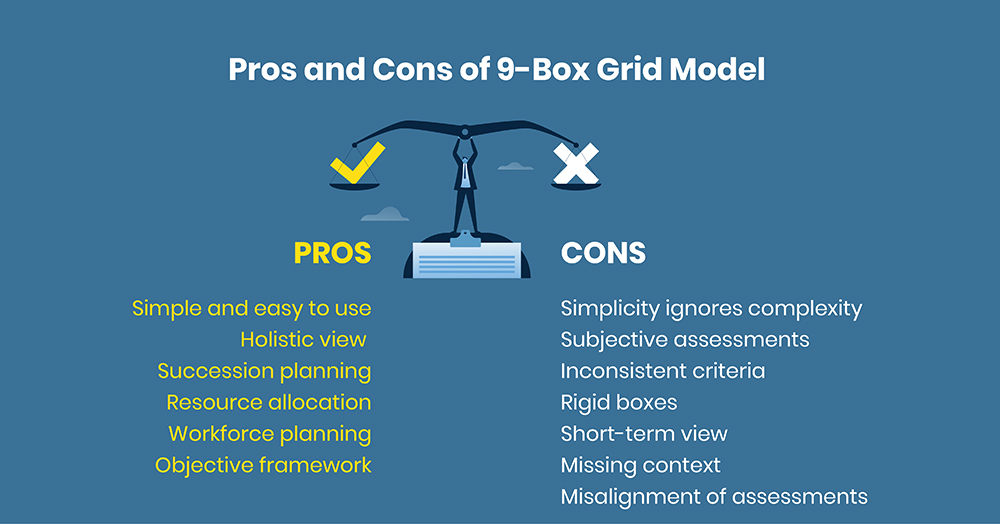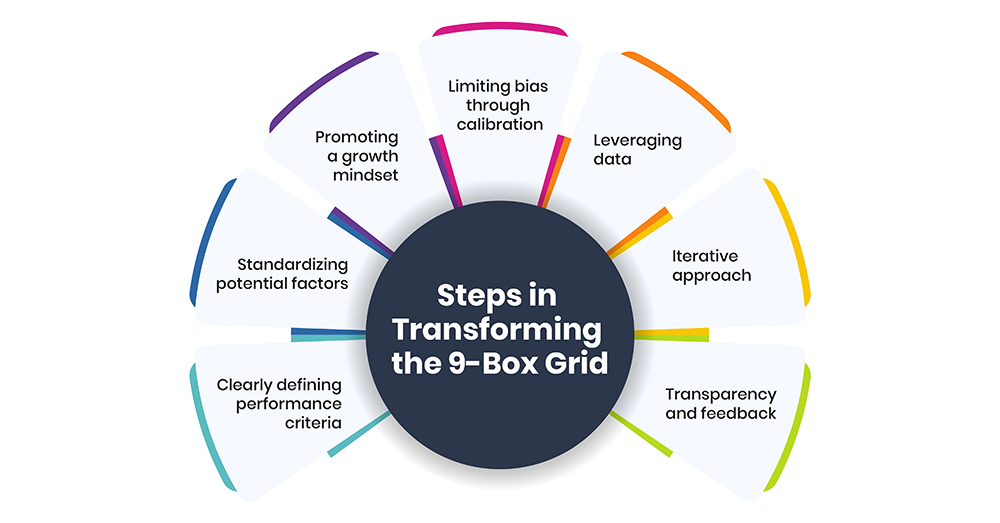
For decades, the 9-box grid has been one of the most ubiquitous tools used by HR professionals to evaluate employee talent. By plotting performance on one axis and potential on another, it provides an at-a-glance view of an organization's talent landscape. However, its simplicity is also its major weakness - critics argue it reduces complex human capital issues to overly simplistic categories that can disadvantage employees and mask biases.
As the workplace evolves, many are re-evaluating traditional talent management practices. Continuous performance conversations, data-driven assessments, and expanded definitions of "potential" can maintain the 9-box's benefits while overcoming limitations. This article explores alternative approaches that maintain the benefits of the 9-box model while overcoming its pitfalls.
Understanding the 9-Box Model
The 9-box grid divides employees into a 3x3 grid based on ratings of their current performance and future potential. Generally, performance assessments evaluate an individual's achievement of goals, competency demonstration, and overall value to their role, while potential ratings focus on a person's capacity and likelihood for increased responsibilities.
Proponents argue it provides a simple, visual framework that streamlines talent identification, development planning, and succession management. By clustering talent, it allows managers to quickly identify high-performers, under-performers, and those ready for career growth.
However, critiques of oversimplification and subjectivity are valid. Reducing human capital to simplified categories risks masking nuances, while relying solely on subjective manager evaluations introduces opportunities for biases like halo effects to influence ratings. If not carefully administered, it can disadvantage some and negatively impact engagement and retention.
Pros and Cons of 9-Box Grid Model
Let’s explore the pros & cons of 9-box grid:

Let’s explore the pros & cons of 9-box grid:
When utilized properly with clear guidelines, the 9-box grid can have some key advantages for organizations:
-
Simple and easy to use: With just two criteria to assess, the 9-box model is very straightforward. Managers can quickly gauge an employee's profile without much effort.
-
Holistic view: It considers an individual's performance as well as future capabilities, offering a balanced perspective versus focusing on just one dimension.
-
Succession planning: The talent management grid helps identify top performers with high growth trajectories who are primed for more responsibilities. This supports leadership pipeline efforts.
-
Resource allocation: Understanding the talent landscape through the 9-boxes assists with prioritizing development dollars towards those with the greatest opportunities.
-
Workforce planning: It gives a snapshot of existing strengths and gaps to plan talent needs across functions and levels.
-
Objective framework: When used correctly with data and feedback, the 9-box can structure conversations and evaluations in an impartial manner.
Cons of using the 9-box grid
However, the 9-box grid is not foolproof and depends a lot on robust processes around it. Some of its limitations include:
-
Simplicity ignores complexity: Reducing individuals to a single point disregards unique traits, motivation levels and career goals.
-
Subjective assessments: Without guidelines, individual biases may influence how managers interpret and use the two dimensions.
-
Inconsistent criteria: What exactly constitutes 'high' or 'low' can differ based on role, seniority, management style etc.
-
Rigid boxes: Stereotyping staff limits opportunities. Not everyone fits neatly and dynamics change over time.
-
Short-term view: Potential is unpredictable and complex. 9-boxes may pigeonhole versus develop talent proactively.
-
Missing context: Key soft skills, collaboration and other factors get left out of the simple rating system.
-
Misalignment of assessments: Without calibration, assessments by one manager could vary greatly from another.
Evolving the 9-box model
While the 9-box framework provides structure, true value comes from the process - ongoing coaching conversations, multi-rater feedback, data insights and development planning that breathe life into it. Organizations need to ensure the grid is used effectively by:

-
Clearly defining performance criteria: Establish measurable, objective yardsticks aligned to job profiles for fair assessments over time.
-
Standardizing potential factors: What exactly denotes 'potential' should be agreed upon across levels and functions for consistency.
-
Promoting a growth mindset: Focus on building on strengths and addressing gaps versus labeling employees stagnantly to foster learning.
-
Limiting bias through calibration: Implement moderation of assessments to reduce subjectivity through contextual performance reviews.
-
Leveraging data: Pull in metrics around skills, contributions, productivity etc. to ground assessments factually as much as possible.
-
Iterative approach: Check in regularly and be open to moving employees considering evolving roles and learning.
-
Transparency and feedback: Ensure transparency in the process and provide actionable coaching versus punitive ratings for continual improvement.
Technology can further optimize the 9-box process. Tools that aggregate competency data, skills profiles and engagement feedback give richer insights beyond a manager’s view. This strengthens the process’s objectivity and makes it ongoing versus periodic and traceable for accountability. Integrated development modules then make growth planning seamless too.
Alternative Approaches to Performance Evaluation and Talent Management
Traditional performance evaluations often rely on annual reviews and subjective ratings, which can sometimes overlook an employee's full potential or specific contributions. To create a more effective and fair assessment process, many organizations are exploring alternative approaches.
-
Alternative 1: Continuous Performance Conversations
Rather than isolated annual or semi-annual evaluations, regular check-ins keep the dialogue ongoing. Frequent "stay interviews" maintain an open discussion of performance, goals, challenges and career aspirations.
For managers, this provides constant insights to support employees. For individuals, it creates transparency around expectations and accommodates changes in work or personal circumstances. Studies show continuous feedback boosts motivation and development compared to intermittent reviews.
Data from day-to-day interactions, project work, collaboration tools and performance management systems provide objective measures to validate or challenge perceptions. With tim
-
Alternative 2: Skills and Credentials Assessments
Assessing competencies through certifications, project work product, contribution to team goals and skills testing maintains a focus on demonstrable abilities rather than subjective ratings. Electronic peer reviews broaden evaluation perspectives.
Competency frameworks define requirements for roles at all levels of the organization. Gap analyses identify areas for development. Stacked rankings based on credentials garnered provide discussable evidence of growth over time.
This delivers transparency, objectivity and fairness. Rather than general potential ratings, evaluations center on attainable, career-aligned skills that support opportunities matching evolving abilities. Outcome-based assessments focus on optimizing individual productivity in service of business goals.
-
Alternative 3: Expanded Views of "Potential"
Traditional 9-box views are potentially narrow as the likelihood for promotions. A more holistic view recognizes potential arises in many forms - leadership skills, specialized expertise, support functions, etc.
Depth in a field versus width across functions reflects varied paths for career growth. "Potential" better gauge abilities to take on new challenges, whether lateral career moves, special projects, mentoring others or expansions of current duties.
Regular development discussions explore interests to align opportunity with passion. Feedback systems invite anonymous perspectives on new skills emergent colleagues have observed. Diverse profiles of high-potential talent, not limited to preconceptions of leadership track, ensure all capable staff feel valued and invested in growing their careers.
-
Alternative 4: Mitigating Bias through Calibration
To offset unconscious biases, cross-functional calibration sessions compare notes and challenge outliers. Managers justify rating discrepancies based on clear performance data rather than vague impressions.
Training enhances self-awareness of biases like affinity for similar others or recency effects. Standardized rating definitions and assessment criteria applied consistently minimize variance in what different evaluators view as meeting or exceeding expectations.
Regular calibration creates a check that no demographics such as gender or tenure systematically receive better or worse evaluations. It establishes performance/potential assessment as a collective, supported process focused on growth, retention and fairness rather than isolated manager opinions.
Change Management Considerations
Adopting new approaches requires sensitivity to impact on existing processes. Pilot parallel systems to prove value before full replacement, and address change management needs. Communicate transparency into new criteria to establish shared understanding and buy-in.
Focus on education, not the judgment of past practices. Explain new safeguards against biases audiences may worry could influence their careers. Emphasize continuous development and opportunity remain organizational priorities through changes to tools used. Gradual, collaborative culture change earns confidence in efforts to optimize talent processes.
Future of Performance and Potential Assessments
As workplaces transition, talent assessments must evolve. Technology now enables data-driven, frequent, multi-rater feedback on growing competencies more representative than isolated reviews. Outcome-based development aligns ability growth with career mapping.
With careful change management, organizations can upgrade their talent grids from high-level overviews to nuanced talent portraits attentive to the diversity of paths, skills and potential across their workforce. Maintaining an engaged, optimally developed staff requires rethinking traditional practices to ensure evaluations empower equitable opportunities for all to fulfil their career ambitions. An emphasis on development over assessment supports talent management fit for modern workplaces.
Conclusion
In conclusion, the 9-box grid remains a simple yet powerful starting point for conversations around performance and potential when done judiciously. But on its own, it is an incomplete and potentially limiting assessment method. Organizations need robust processes and guidelines to leverage people data along with the grid’s framework to yield a real impact on employee experience and organizational success through meaningful talent management. With a calibrated implementation that promotes transparency, continual growth and fairness, the 9-box approach can effectively balance performance evaluation with development support.




